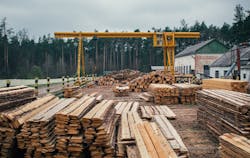Low Domestic Sawmill Output Slows Home Construction
Despite strong nationwide housing demand, low domestic sawmill output is slowing construction and contributing to major price volatility nearly two years into the COVID-19 pandemic. Low mortgage interest rates and new generations of homebuyers are boosting demand for new construction, but insufficient lumber production in the U.S. is widening a housing deficit and pushing prices to record highs.
Sawmill output rose 3.1% year-over-year in September, but 2021 rates were just 1.6% higher than output in 2019 despite higher demand and lower total housing supply, according to the NAHB’s Eye on Housing.
The following economic data track estimates concerning the sawmill industry (NAICS 3211) and clearly indicate that domestic production has not kept pace with the gains for home construction since mid-2020.
A cited reason for the lack of lumber production in the U.S. has been challenges with labor, a limiting factor for the overall economy in both the manufacturing and construction sectors.
However, Bureau of Labor Statistics data indicate that sawmill industry employment is higher than a year ago. As of October 2021, the most recent data available, sawmill employment was 90,100. This is a 2.4% increase from October 2020, or a net gain of 2,100 jobs. Residential construction employment was up 4.0% or 118,500 net jobs over the same period.
